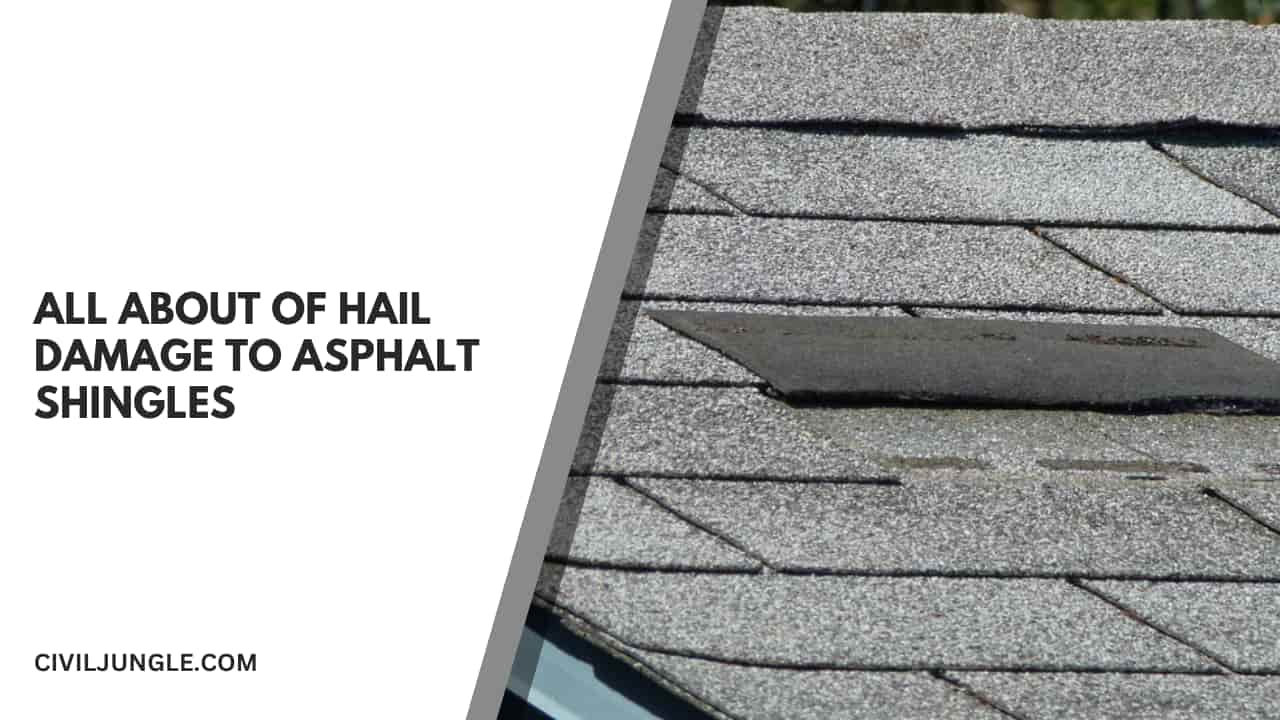
Introduction of Hail Damage to Asphalt Shingles
As humans came into this world, at first, they started living in caves made from Rocks. The primary intention for living in caves was to protect themselves from adverse environmental conditions such as rain, storm, wind, etc; and also, to protect themselves from the attacks of wild animals.
Although caves fulfilled their primary intention, humans with their developing brains, soon realized the need for more. They eventually grew aesthetic and architectural sense, and also the need for permanent belongings.
As caves were not able to fulfill that, humans started thinking of building their own “homes” rather than living in caves. So, they started gathering materials and started building homes using their concept. With progressing time, the homes they have built soon started facing various challenges.
As the primary material for construction was Wood, many a time, then the fire broke out in their house (as wood is very much susceptible to fire), while in some other times, the wood easily decayed due to presence in moisture, which as well as indirectly responsible for the growth of insects.
Thus, facing such challenges, the construction materials evolved as well. With the time of evolutions of construction, the concept of asphalt shingles and hail is coming.
There has a controversy arises that how hail damage to asphalt roof shingles occurs and actually what hail damage shingles look like.
What Is Hail and How Does It Damage the Asphalt Shingles?
In simple words, Hail can be defined as a crystallized piece of snow. Many a time hail is confused with the ice pellets, but that’s often not the case. Ice pallets are generally solid precipitation of particles less than 5mm, which are generally spherical and circular, but rarely conical in shape.
Ice pallets are generally formed as the raindrops fall through the cold air. The raindrops as they fall through cold air and clouds, soon lose their temperature and come in Sub-zero temperature.
As they come in Sub-zero temperature, a thin layer of ice is formed converting the liquid raindrops. Many a time, while falling through the air, a fall in temperature might be witnessed, thus again converting the ice pallets into raindrops.
The size of ice pallets is far smaller than the size of hail, so it does not damage any roofs while falling. Many times, while falling through the thin layer of ice is again broken and again reverts to its original form, that is liquid rainwater.
Thus, it can be said that hail is generally formed by keeping a lot of ice pallets together. The formation of hail can be generally witnessed in cold regions. In those regions and all other regions as well, the air temperature rises as the height gets increased.
Thus, the temperature of the air at a higher place is larger than the temperature of the air at a lower place, keeping the geotechnical coordinates the same. As per the concept of transpiration, the warmer air gets upward, while the colder air gets downward.
So, the process starts from the evaporation of water due to continuous heat. As the water evaporates from the surface sources, it gets stored up in the lower layer of air, which is warmer.
Due to the up drift of warmer air (meaning warmer air gets higher), the rainwater stored in the lower layer of air gets upwards. As the temperature of the upper air, is much below the lower air, the raindrops generally fall below Sub-zero temperature and form thin ice.
As the weight of the ice is greater than the raindrop itself, it falls in the lower layer of air. As it falls in the lower layer of air, it generally melts into raindrops again.
Hails are generally the pieces of solidified raindrops, formed through the cycle of transpiration and evaporation, and have a size bigger than 5 millimeters.
These can cause hail damage to shingles and even wind damage to architectural shingles. And also, the hail damage the asphalt shingles by many ways like some specialist says it is torn, punctured and fractures on the asphalt mats.
Some time by the reaction of hail on the asphalt roof shingles, the granules are dislodged from the asphalt math of the impact area.
Hail Damage to Asphalt Shingles
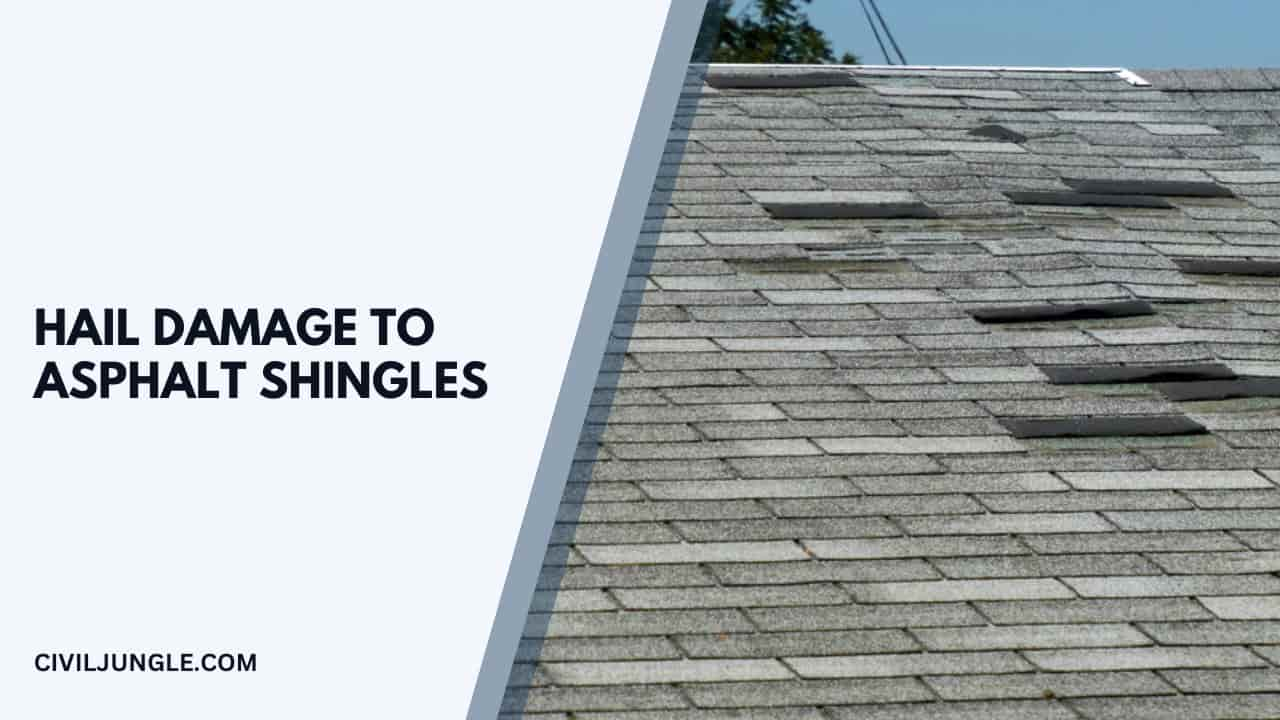
Here, two different types of examination are as follows.
1. Inspect the Exterior Shingles

Due to storms, the roof of the houses is damaged widely because they are protected you as a front-line defense against tough outdoor weather conditions.
Then we check curling, granular loss, cracked shingles, missing shingles, etc. We need to hire a roofing contractor for inspection purposes or use a binocular.
2. Missing Shingles
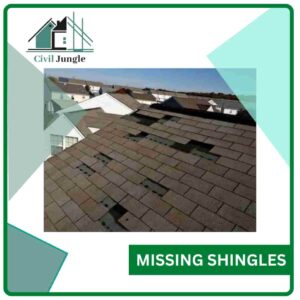
Sometimes when a high wind storm has occurred then some asphalt shingles can be missing by the high wind and for this, some leaks create on the roofs. To avoid more serious water damage for leaks we should prevent the leaks by waterproofing seals.
Sometimes when there is seen a large number of shingles that are missing in this situation some homeowners are want to replace the whole roofing system.
Hail Damage of Asphalt Roof Shingles Components
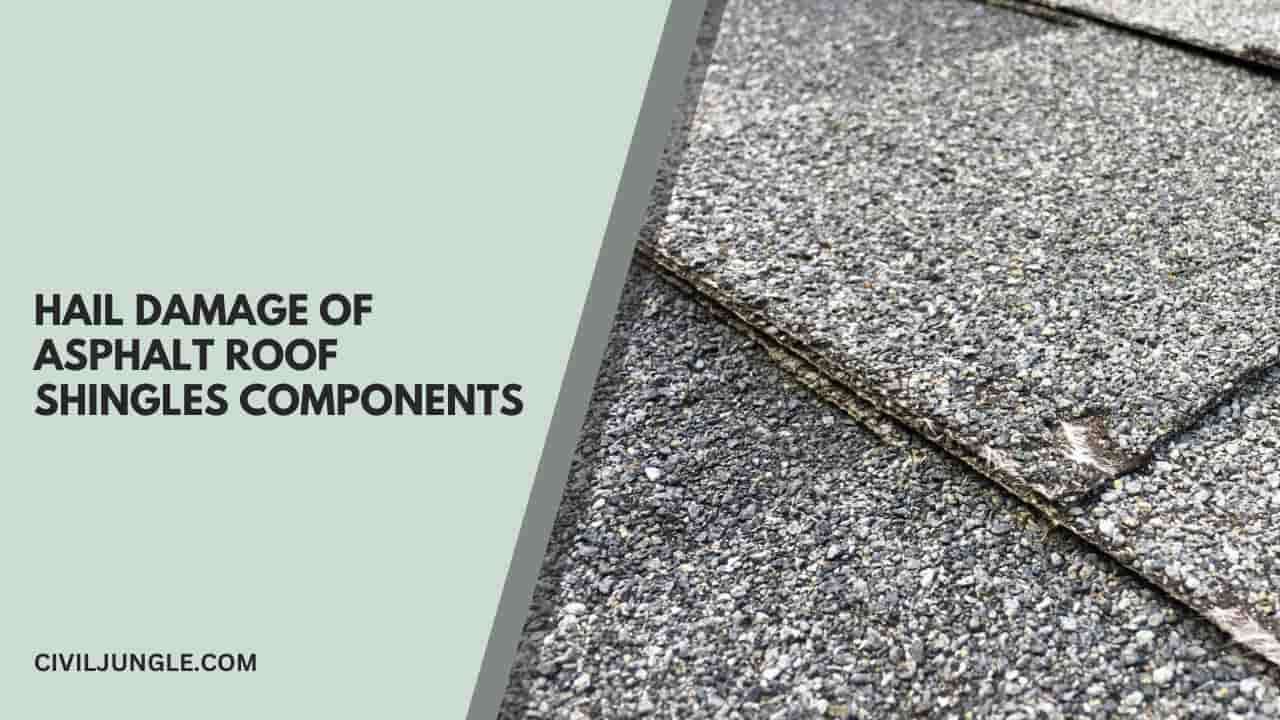
On the market, today asphalt roof shingles are affordable and one of the most common roofs covering materials. In the asphalt roof shingles, the base materials are glass-fiber that is an inorganic material or the other one is paper that is an organic material.
With the limestone power, of asphalt an asphaltic mixture of composed and also another mineral stabilizer like fillers. On the asphalt shingles, surface granules are applied to provide weight, color and to block the deleterious effect of the sun on the underlying asphalt.
In this asphalt roof shingles with a ceramic material, the crushed stone coated granules are used. The ceramic is used to provide the color of the ceramic. Generally, the weight of the granules is one-third of the asphalt shingles, and one-third is asphalt and the rest of one-third is filler material.
In the total weight of the asphalt shingles, the weight of the mat is a small fraction. In various shapes, sizes, athicknessesess the asphalt roof shingles are available in the market. Generally, the cost of the asphalt shingles will be increasing the heaver or thicker of the shingles.
In the constructions, the asphalt shingles which are mostly used that’s are laminated and three-tab varieties.
Hail Damage: Granule Loss Study
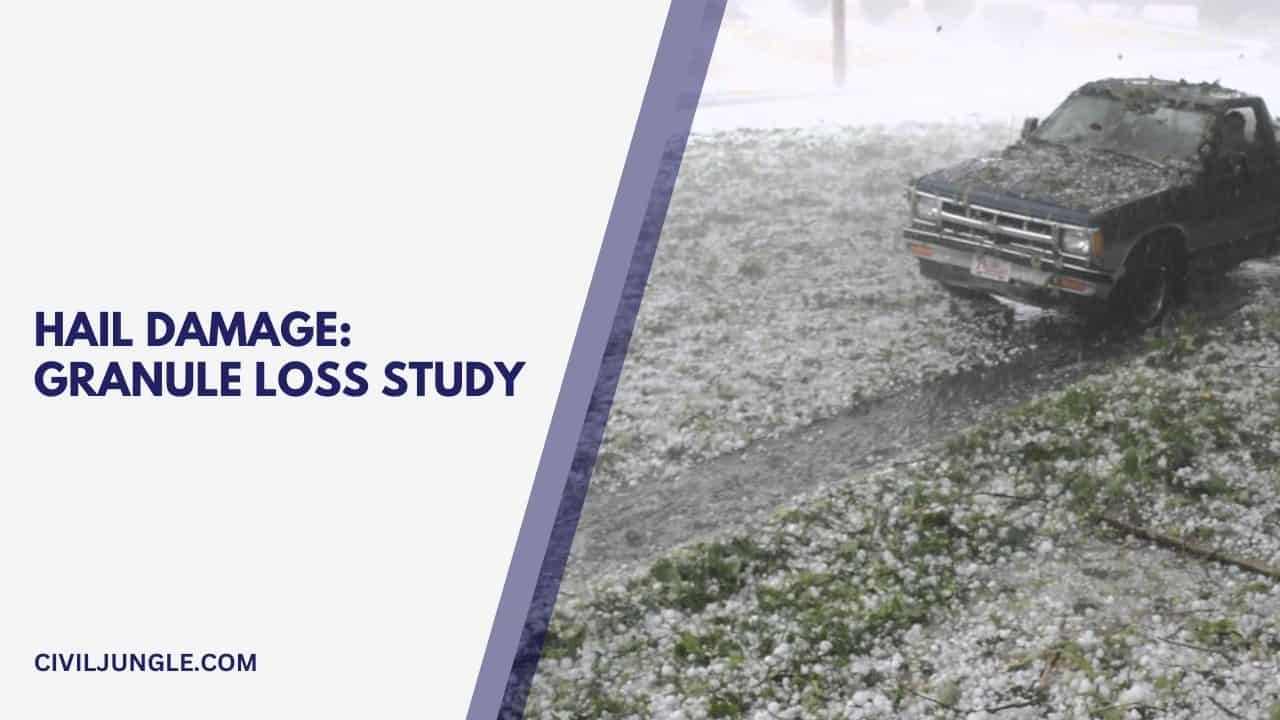
In the asphalt roof shingles, how many granules are removed on the affected area that’s affect the water-shedding ability or the service life of shingles, this process named by the author is a granule loss study on asphalt shingles?
With a wire brush, the quantities of removing granules are varying from new glass-fiber and three-tab mat shingles. After that for ten years, for the weather conditions in Texas and Dallas, the asphalt shingles are exposed naturally.
Approximately, 5, 15, 45, 70 % ( percent ) of granules are removed from the total amount of granules of the asphalt shingles. An upside-down shingle was installed when by the weather the asphaltic mat was exposed.
On the south-facing over wood conventionally the asphalt shingles were installed on a 4:12 pitch. AtAfterhe the study at intervals of ten years period the shingles were examined as well.
The exposed asphalt, in one year, had oxidized grey but on the surface of the shingles has no visible evidence of crack or erosion. The shingles to shed water after five years have oxidized of the exposed shingles area but the functions of the shingles did not affect.
Without granules shingles, surface erosion was visible on the shingles and the other hand had become glass fiber had become exposed. Without granules, after 10 years in the shingles, no significant change was noted. Due to erosion, the life longevity is a decrease of the asphalt shingles.
Hail Damage: Assessing Hail Damage

Assessing wind damage to asphalt roof shingles and hail damage on shingles is a long process that’s occurred step by step examination of other things around the roof and the roof shingles. This often involves using a test square roof methodology.
By using of test squares methodology, Herzog and Marshall presented to a roof how to quantify hail damage.
On each directional roof slope in test squares are counted the number of hail damaged shingles, and whether the roof slope is required that determines the number of hail damage that’s happened on roof shingles, by the use of DURA formula it can be replaced.
If there have no underlying support or have little especially along eaves, rakes, ridges, and valleys by hail damaged shingles are particularly susceptible. To be broken or chipped also are vulnerable to shingles edges.
Therefore, must be examined the entire roof carefully, when you examined the roof you can see if there are have many months of exposed asphalt it will provide a grey color surface and if it is recently exposed then it will provide a weathered or black surface.
You can say which one is new hail damage estimate sheet and which one is old hail damage by the color difference.
FAQ on Hail Damage to Asphalt Shingles
What Is Hail, and How Is It Different from Ice Pellets?
Hail is a crystallized piece of snow that forms through a cycle of transpiration and evaporation, with sizes typically larger than 5 millimeters. In contrast, ice pellets are smaller solid precipitation particles, generally less than 5 millimeters in diameter, formed when raindrops fall through cold air and freeze.
How Does Hail Damage Asphalt Shingles?
Hail can damage asphalt shingles by causing tears, punctures, and fractures in the asphalt mat. The impact can dislodge granules from the shingles, weakening their structure and reducing their lifespan.
What Are the Signs of Hail Damage on Asphalt Shingles?
Common signs of hail damage include missing shingles, curling, cracked shingles, granular loss, and punctures or tears on the asphalt mat. Dislodged granules and exposed underlying materials can also indicate damage.
How Can I Inspect My Roof for Hail Damage?
To inspect for hail damage, check for curling, granular loss, cracked or missing shingles. Using binoculars or hiring a roofing contractor for a thorough inspection is recommended, especially after a storm.
What Should I Do If My Shingles Are Missing After a Hailstorm?
If shingles are missing, it’s crucial to prevent further damage by sealing leaks with waterproofing measures. Consider replacing the entire roofing system if a significant number of shingles are missing.
What Are Asphalt Shingles Made Of?
Asphalt shingles are made from a base material of glass-fiber (inorganic) or paper (organic), coated with an asphaltic mixture and mineral stabilizers like fillers. Surface granules made from crushed stone and ceramic materials are applied to add weight, color, and UV protection.
How Does Granule Loss Affect Asphalt Shingles?
Granule loss affects the water-shedding ability and service life of asphalt shingles. Significant granule loss can lead to surface erosion, exposing the asphalt mat and reducing the shingles’ longevity.
What Is a Granule Loss Study?
A granule loss study assesses the extent of granule removal from asphalt shingles in affected areas and its impact on the shingles’ performance. This study involves measuring the quantity of removed granules and examining the shingles over time.
How Can Hail Damage Be Assessed?
Hail damage assessment involves a thorough inspection of the roof and surrounding areas. The test square methodology, which counts the number of hail-damaged shingles in specific areas, helps quantify the damage and determine the necessary repairs.
What Should I Look for During a Hail Damage Inspection?
During an inspection, check for signs of damage like exposed asphalt, grey or black surfaces indicating weathering, and broken or chipped shingle edges. Pay special attention to areas with little underlying support, such as eaves, rakes, ridges, and valleys.
Can Hail Damage Be Repaired, or Do I Need to Replace the Entire Roof?
The extent of hail damage will determine whether repairs or a complete roof replacement is necessary. Minor damage may be repaired, but significant or widespread damage often requires replacing the entire roofing system to ensure proper protection.
How Does Hail Damage Impact the Longevity of Asphalt Shingles?
Hail damage can significantly impact the longevity of asphalt shingles by causing structural weaknesses, granule loss, and surface erosion. Proper assessment and timely repairs are essential to maintain the roof’s durability and performance.


